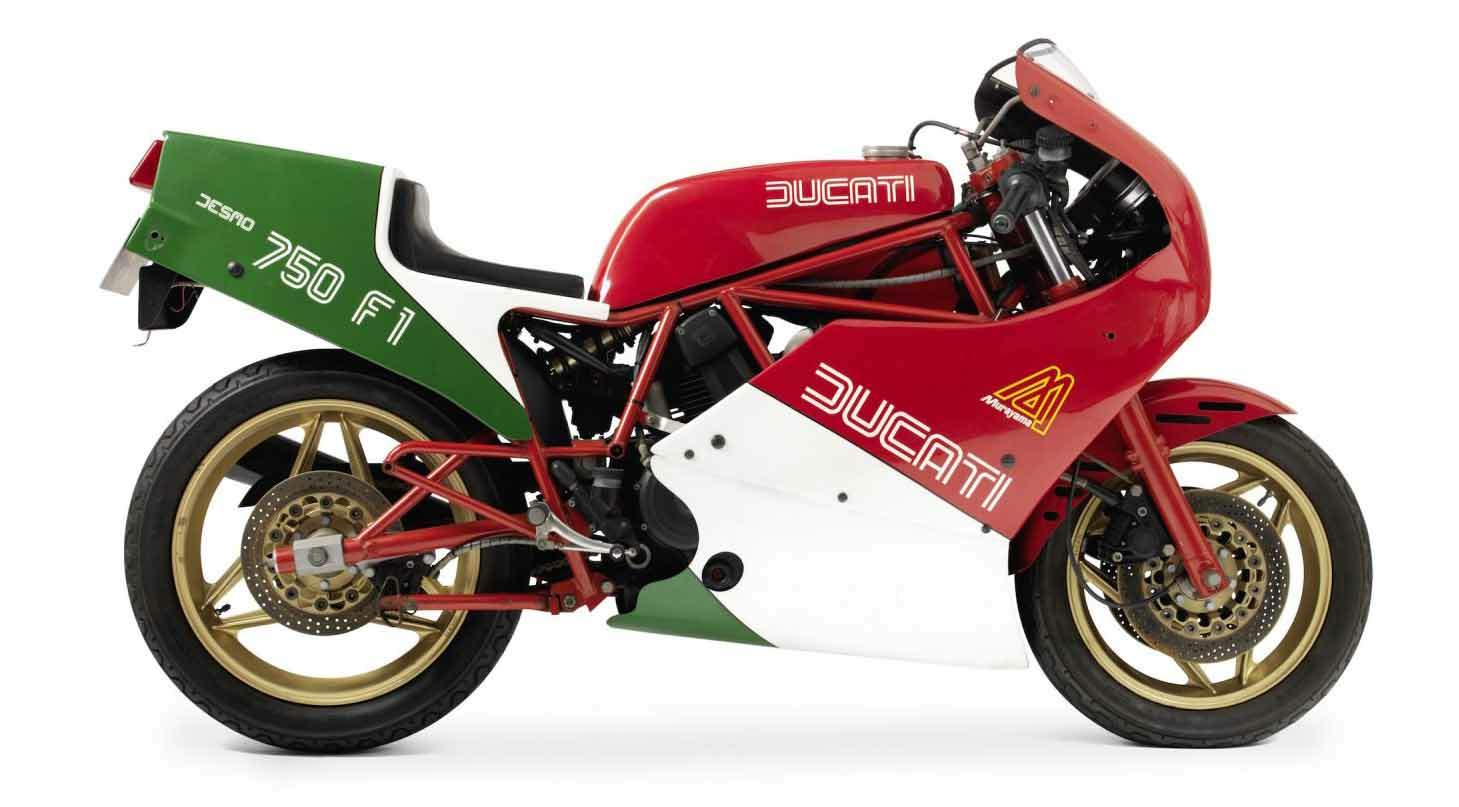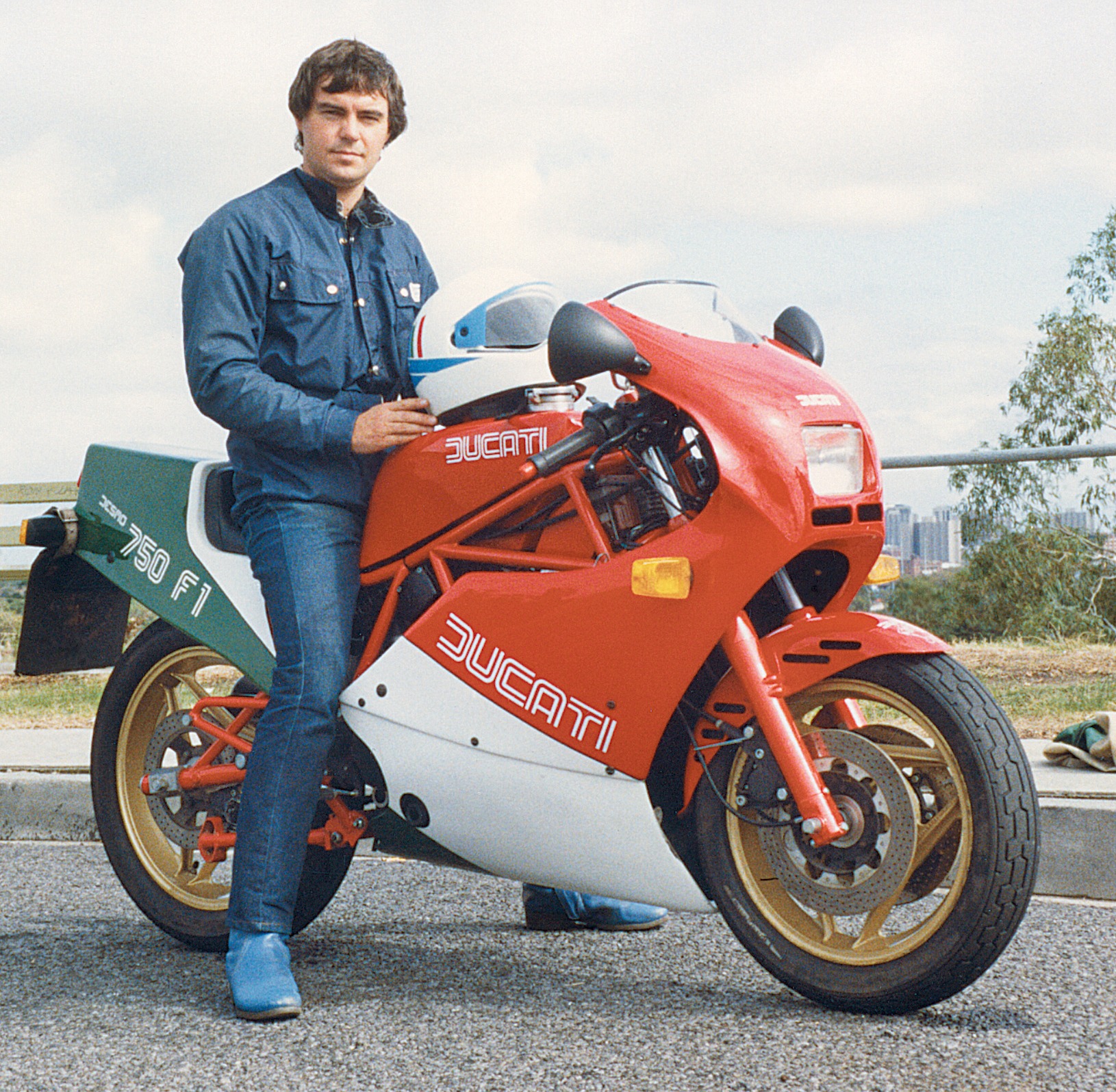Motorcycle Investor mag
Subscribe to our free email news
Ducati 750 F1
(by Ian Falloon, Feb 2022)

Falloon
unwraps the last of the loud and proud air-cooled
racer replicas
To many Ducati enthusiasts,
the last real Ducatis finished with the Cagiva takeover
in 1985. Before this all Ducatis had the stamp of Ing.
Taglioni firmly on them and the best were generally
unadulterated sporting motorcycles built not to a price,
but within a particular philosophical framework. It
didn't really matter how much it cost to build them or
whether they sold well. The 750 F1 represented the end
of this era.
The F1 continued a line of
race-replica production bikes that established the
Ducati legend. These included the 250 Mach 1, 750 Super
Sport “Green Frame”, 900 Super Sport and 900 Mike
Hailwood Replica. While the 750 F1 was impressive, more
so were the three series of limited editions; the
Montjuich, Laguna Seca, and Santamonica. Each was named
after a racetrack where the 750 F1 had won races, and
were higher performing models than the standard model.
Continuing the tradition was
a considerable price increase over the standard machine.
In 1987 the Laguna Seca cost nearly $15,000, 50 per cent
up on the regular F1. You had to be keen to want one and
only seven were sold in Australia.
The 750 F1’s roots lay in the
magnificent 600 cc TT2 racer. The TT2 was ostensibly a
600 Pantah engine housed in a compact trellis frame with
a cantilever rear end. It epitomised Taglioni's
philosophy of success through minimalism, and useable,
rather than outright horsepower.
Racing versions weighed 130kg
and produced around 76 horsepower at 10,750 rpm and
Massimo Broccoli rode one to victory in the 1981 Junior
Italian TT F2 Championship.
The same year veteran British
rider Tony Rutter won the TT2 World Championship on a
heavily modified Pantah and for 1982 Ducati provided him
a factory TT2. Rutter rewarded them with successive TT2
World Championships over the next three years, his
string of four consecutive World Championships between
1981 and 1984 Ducati’s most significant until that time.
When World Endurance racing
regulations changed for 1984, limiting engine capacity
to 750 cc, it was an easy job for Taglioni and his
racing department to enlarge the TT2 to 748 cc, creating
the TT1 endurance racer.
While the TT1 wasn't nearly
as successful as the TT2 they were magnificent machines
nonetheless. These factory TT1’s featured rising rate
rear suspension and most had 16-inch wheels front and
rear.
As far back as 1982 there
were plans to produce a street version of the TT2, but
typically it took a while in coming. Ducati was
struggling to survive during this period and about to be
bought by Cagiva.
The 750 F1 was released in
1985, followed by an improved version for 1986. Also for
1986 the first limited edition 750 F1 was offered, the
Montjuich. The Barcelona 24 Hour endurance race held at
Montjuich Park had long been a successful event for
Ducati, and in July 1983 Benjamin Grau, Enrique de Juan
and Luis Reyes won on a prototype 750 TT1. Thus the
first limited edition F1 was titled the Montjuich.
Ducati subsequently prepared
a special 750 F1 for Marco Lucchinelli in the Battle of
the Twins racing in America during 1986. Lucchinelli won
the Battle of the Twins race at Daytona in March and
later that year went on to win the Battle of the Twins
race at Laguna Seca in California.
The race win at Laguna Seca
prompted Ducati to name the 1987 limited edition 750 F1
the Laguna Seca and provide each with a Marco
Lucchinelli decal autograph on the fuel tank. Arguably
the 750 F1’s most significant victory was Lucchinelli's
win over Joey Dunlop’s factory Honda RVF750 at the
Santamonica circuit in Misano in the 1986 F1 World
Championship. This led to the third series for 1988, the
Santamonica.
All three series were similar
in basic specification. The 750cc engine shared the 88mm
bore and 61.5mm of the factory racers, and was more
highly tuned than the cooking F1. With longer duration
and higher lift camshafts, along with Dell’Orto PMH 40
ND/NS carburettors with open bell mouths the power was a
claimed 95 horsepower at 10,000 rpm. Even Luigi in his
dreams couldn’t believe such a fanciful figure, but at
least it was one way to justify the outrageous price.
In Ducati’s best race replica
tradition, they were closely related to the race bikes.
The cantilever swingarm was aluminium Verlicchi, the
front fork a 40mm Forcelle Italia, with a Marzocchi
oleo-pneumatic rear shock absorber. With the Laguna Seca
there was some evidence of cost cutting under the new
Cagiva regime (Cagiva purchased Ducati in 1985).
Instead of the expensive,
composite Marvic/Akront magnesium/aluminium wheels of
the Montjuich and Santamonica, the Laguna Seca took its
wheels straight off the 750 Paso. These aluminium Oscam
wheels had wider rims, a 3.75 x 16-inch on the front and
5.00 x 16-inch on the rear, and allowed the fitting of
wider and lower profile Pirelli radial tires.
While the Montjuich and
Santamonica featured fully-floating cast-iron disc
rotors, the Laguna Seca front discs were non-floating
280mm, bolting directly to the wheel without a disc
centre. The Laguna Seca did however retain the best
quality brake calipers available in 1987, racing Brembo
“Gold series” four-piston calipers. Rolling on a 1400mm
wheelbase, and weighing a scant 155 kilograms, the
Laguna Seca was tiny.
Production of all the limited
edition F1s was extremely limited. After only 200
Montjuichs built Laguna Seca production totalled 296.
This included 146 as dual seat (Biposto) versions like
this example, 50 of those US spec with a quieter
muffler.
Over 30 years on the limited
edition 750 F1 is now almost forgotten. These were the
last Ducati air-cooled race replica twins. Noisy and
uncivilized, they had no place in a new order dictated
by governments and regulations and more sanitary models
soon replaced them.
The Laguna Seca may be
flawed, but it has a character that exemplifies the
spirit of Ducati. One ride is enough to convince that
you could be Marco Lucchinelli leading the field through
the corkscrew at Laguna Seca.

Falloon with what was then a brand new F1, up on Kew Boulevard in Melbourne.
-------------------------------------------------
Produced by AllMoto abn 61 400 694 722
Privacy: we do not collect cookies or any other data.

Archives
Contact





